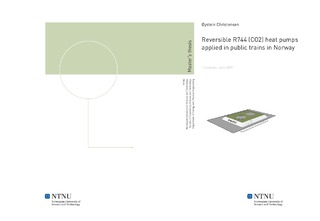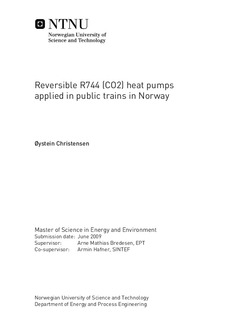| dc.contributor.advisor | Bredesen, Arne Mathias | nb_NO |
| dc.contributor.advisor | Hafner, Armin | nb_NO |
| dc.contributor.author | Christensen, Øystein | nb_NO |
| dc.date.accessioned | 2014-12-19T11:44:25Z | |
| dc.date.available | 2014-12-19T11:44:25Z | |
| dc.date.created | 2010-09-03 | nb_NO |
| dc.date.issued | 2009 | nb_NO |
| dc.identifier | 347832 | nb_NO |
| dc.identifier | ntnudaim:4823 | nb_NO |
| dc.identifier.uri | http://hdl.handle.net/11250/233614 | |
| dc.description.abstract | This report presents opportunities for use of CO2 as refrigerant in the air conditioning system in public trains. The CO2 system shall provide cooling in the summer and heating in the winter. CO2 is a natural fluid which means that it exists naturally in the biosphere. Today 75% of the air conditioning systems in trains use R134a as refrigerant. The GWP of R134a is 1410 while CO2 used as refrigerant is 0. A replacement from R134a to CO2 gives possibilities of large environmental savings. Three different technical system solutions of the heat pump are presented, each with its own method of provide cooling and heating. Solution I changes between cooling and heating by change the direction of the refrigerant flow through the system. Solution II changes between cooling and heating by change the configuration of the air streams through the heat exchangers. In Solution III the refrigerant flow direction and the configurations of the air streams is always the same. The whole heat pump is placed on a rotatable unit and the change between cooling and heating is done by rotating the whole heat pump 180°. In all the three technical solutions there are separated heat exchangers for fresh and exhaust air. This gives an energy efficient system which recover heat from the exhaust air. Computer simulation shows that a system solution with one evaporation pressure and one stage compression is problematic for low ambient temperatures; the system must stand temperatures to 40 °C. A system solution with two levels on the evaporation pressure and a two stage compression showed to improves the COP from 1,7 to 3,2 when the ambient temperature at 40 °C. A railway coach need cooling when the ambient temperature is above 20 °C and heating below 15 °C. Norway is a country with cold climate. Weather statistic show that a train which drives in Oslo every day from 0600 to 1800 throughout a year will need cooling 3% of the time and heating 83% the time. This heating should be done by a heat pump and not with electrical heating as today. Results of the computer simulation shows that the annual energy consumption of heating the train will be reduced by 78 % if the designed CO2 heat pump is used in stead of electrical heating. | nb_NO |
| dc.language | eng | nb_NO |
| dc.publisher | Institutt for energi- og prosessteknikk | nb_NO |
| dc.subject | ntnudaim | no_NO |
| dc.subject | SIE5 energi og miljø | no_NO |
| dc.subject | Varme- og energiprosesser | no_NO |
| dc.title | Reversible R744 (CO2) heat pumps applied in public trains in Norway | nb_NO |
| dc.type | Master thesis | nb_NO |
| dc.source.pagenumber | 107 | nb_NO |
| dc.contributor.department | Norges teknisk-naturvitenskapelige universitet, Fakultet for ingeniørvitenskap og teknologi, Institutt for energi- og prosessteknikk | nb_NO |

